
Breast Augmentation, Everything you need to know about the number 1 breast operation
The breast is often considered a symbol of femininity and sensuality. For many women, the shape and volume of their breasts contribute to their sense of well-being and self-confidence. If you feel that your breast size is insufficient, whether due to congenital reasons, the effects of breastfeeding, or significant weight loss, breast augmentation through cosmetic surgery can be an effective solution. This procedure aims to restore or create the desired breast volume, thus contributing to the harmony of the figure and enhancing self-esteem.
Breast Augmentation details
Breast Augmentation
Prices
About
Definition of Breast Augmentation
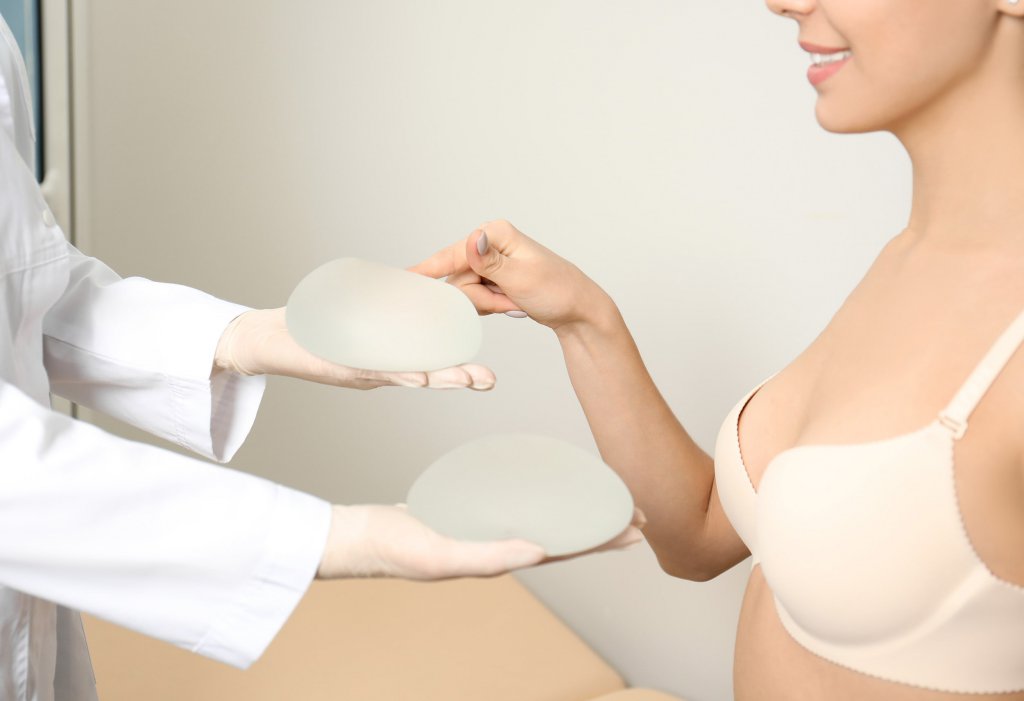
Choosing your breast implant
Breast augmentation is a procedure aimed at increasing the volume of the breasts by placing silicone or saline-filled breast implants, or by injecting your own fat.
This surgery can:
- Increase the fullness and projection of the breasts.
- Improve the balance of the breast contours.
- Enhance self-image.
The lifespan of implants varies from person to person. While no replacement is necessary, some new generation implants are designed to last longer. The choice of the implant and its size is a decision made in consultation with the surgeon, taking into account the patient's morphological characteristics.
Methods of Introducing Breast Implants
The insertion of breast implants can be done using three main techniques, each offering specific advantages depending on the patient's needs and characteristics.
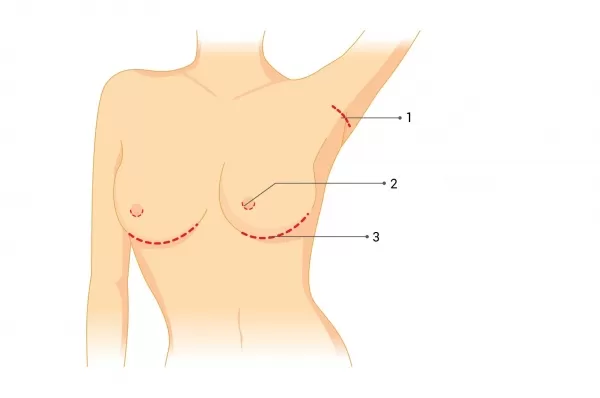
Breast implant insertion methods
- Axillary Approach: The incision is made in the armpit, avoiding any scars on the breast. This method is particularly appreciated for its aesthetic aspect.
- Periareolar Approach: This method involves an incision around the areola. It is ideal for adjustments of the nipple or areola position, and the scar is often well concealed.
- Submammary Approach: The incision is made in the fold under the breast, allowing good visibility and easy access for the surgeon. It is often preferred for larger implants.
The prostheses can be placed behind the mammary gland or the pectoralis major muscle. There are three main surgical approaches for the introduction of implants: the periareolar route, the submammary route, and the axillary route.
Stages of Breast Augmentation Surgery
- First step: Clinical Examinations - The doctor examines the breasts and determines the desired size, in accordance with the patient's body shape, to plan the breast augmentation surgery.
- Second step: Necessary Tests - Blood tests are carried out to check blood sugar levels and exclude any pathology that may contraindicate the operation, such as diabetes, hypertension, or immunodeficiency.
- Third step: Patient Preparation - The medical staff prepares the patient, then the anesthesiologist proceeds with general anesthesia to ensure a pain-free operation.
- Fourth step: Surgical Intervention - The surgeon inserts the breast implants (either via the periareolar route, the submammary route, or the axillary route), or proceeds with breast lipofilling by reinjecting the previously filtered fat.
Conditions for Breast Augmentation Surgery
To be a candidate for breast augmentation surgery, it is essential to meet certain conditions:
- Be over 18 years old with completed breast growth.
- Be in good general health and free from diseases that could compromise the surgery.
Main Indications for Breast Augmentation
Breast augmentation is particularly indicated in the following cases:
- Change in breast size due to weight loss, pregnancies, childbirth, or breastfeeding.
- Loss of breasts due to cancer or an accident.
- Asymmetry or loss of breast fullness.
- Dissatisfaction with the size or overall appearance of the breasts.
Advice for Pre-Breast Augmentation Surgery
Before undergoing breast augmentation surgery, it is important to follow certain medical instructions:
- Avoid smoking at least one month before the operation to promote good blood circulation.
- Stop taking anticoagulant medications like aspirin and ibuprofen.
- Limit the consumption of stimulants such as caffeine two weeks before the operation.
- Avoid anticoagulants containing vitamin E to reduce the risk of bleeding during surgery.
Anesthesia for Breast Augmentation
Breast augmentation is systematically performed under general anesthesia, ensuring the comfort and safety of the patient during the procedure.
Placement of Breast Implants
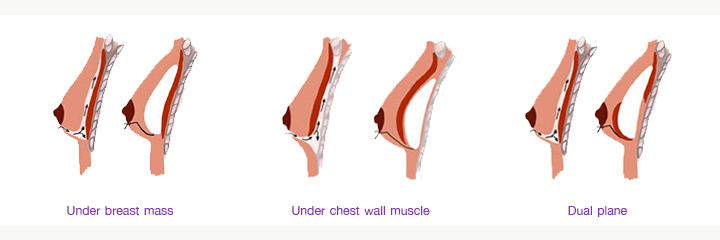
Breast implant placements
The placement of breast implants is done using three main approaches, each with specific implications on the appearance and feel of the breasts after surgery.
- Above the muscle (subglandular): The implant is placed between the breast gland and the pectoral muscle. This approach is often chosen for its quicker recovery and natural look, especially in women who already have a certain breast volume.
- Under the muscle (submuscular): The implant is placed under the pectoral muscle. This method is favored for women with little breast tissue, offering a more natural look and reducing the risk of implant palpability.
- Dual plane (mixed): This technique combines the previous two methods, where part of the implant is under the muscle and the other part is above. It is often used to optimize the appearance of the breasts based on the individual characteristics of each woman.
Dual Plane Placement of Breast Implants
The dual plane, or two-level, positioning is an advanced technique for breast implantation. It combines the advantages of submuscular and subglandular placements:
- Upper part of the prosthesis: Positioned behind the pectoral muscle, offering a natural appearance, especially in women with little breast tissue.
- Lower part of the prosthesis: Placed behind the breast gland, allowing for better filling and giving a more voluptuous look.
This dual plane method allows for a very natural result, especially thanks to a nice unfolding of the subareolar segment, which is the area between the areola and the submammary fold. This technique is ideal for patients who wish to combine the naturalness of submuscular placement with the volume and curvature offered by subglandular placement.
Results
Although the result of breast augmentation is immediately visible, it will stabilize over the months, once the postoperative edema has decreased and the breasts have taken their final shape.
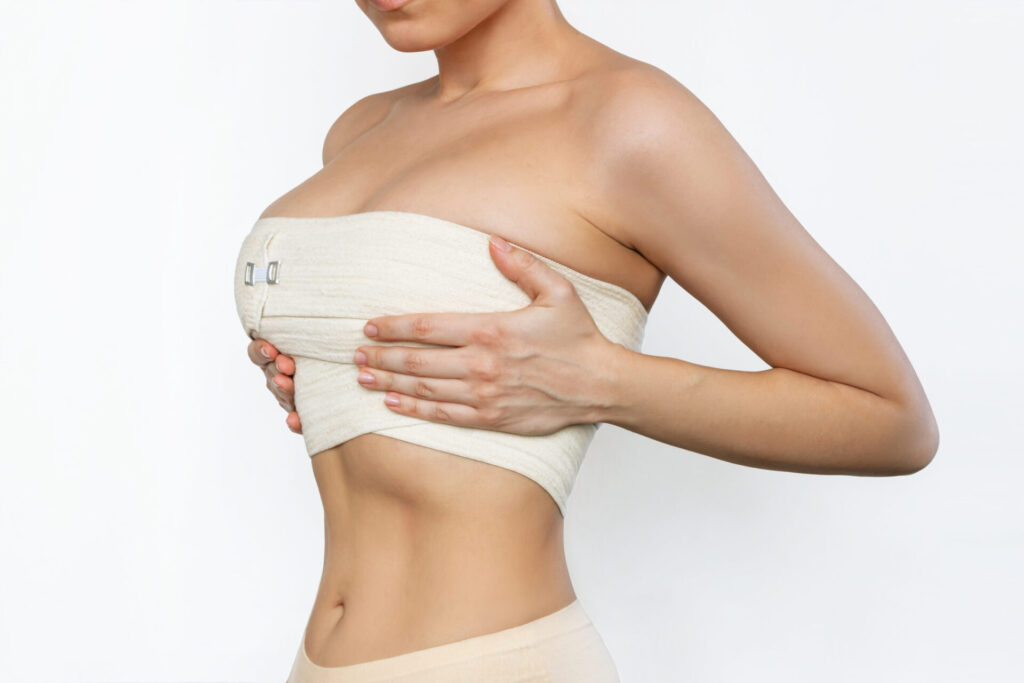
Postoperative after breast augmentation
Convalescence
Post-operative recovery from breast augmentation can include initial pain, especially if the implant is placed behind the pectoralis major muscle. Pain management is usually prescribed. Breast pain and changes in sensitivity are possible. A rest of 72 hours is recommended, as well as wearing a special bra for 3 weeks.
Post-Operative Breast Augmentation Tips
The recovery period varies from four to six weeks. It is crucial to follow medical instructions to promote healing:
- Wear a medical bra for one month after surgery.
- Avoid strenuous efforts and exercise for at least one month.
- Continue to avoid smoking for two months after surgery.
- Avoid high temperatures, such as saunas or Turkish baths.
- Avoid direct sun exposure for one month after surgery.
- Avoid carrying heavy objects for four to six weeks.
Most patients can resume their daily activities after two or three days, except for intense physical activities. Skin sensitivity may be altered initially but usually returns to normal between the third and fourth month.
FAQ
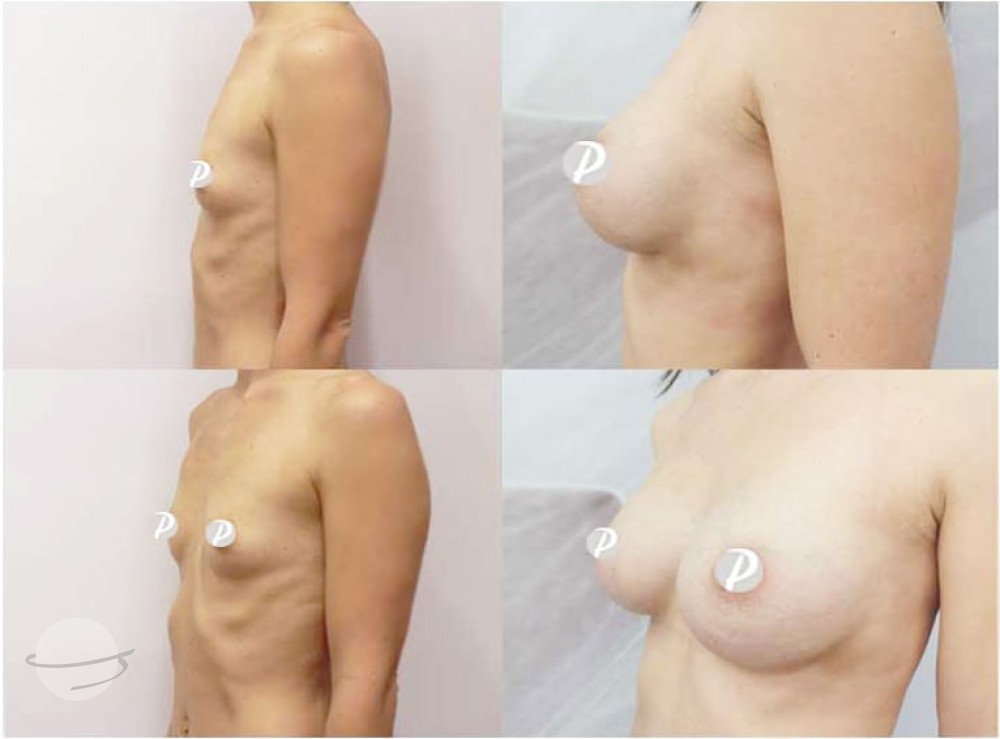
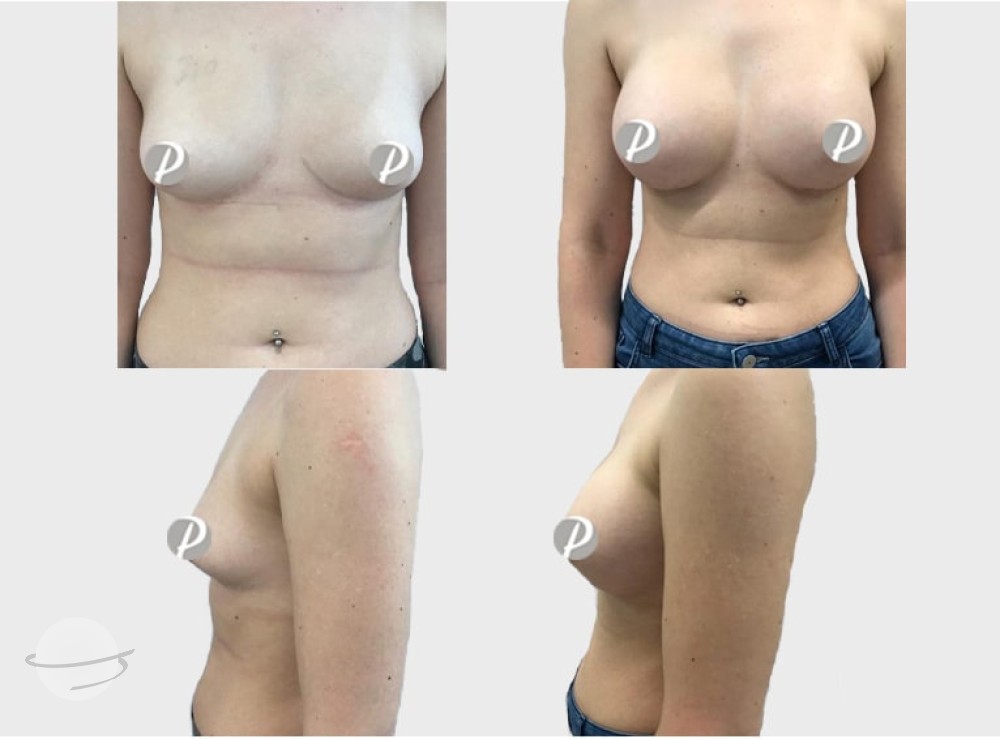
Breast lipofilling
Prices
About
What is Breast Lipofilling?
Breast lipofilling is a technique aimed at increasing breast volume using the patient's own fat. This involves harvesting fat from the patient and reintroducing it into the breasts, potentially increasing size by one to one and a half cup sizes.
The advantage of this method is its natural result; it does not require the introduction of foreign objects such as implants or prostheses. Scarring is minimal, and the fat cells are harvested through gentle liposuction, purified, and then reinjected into the breasts using micro cannulas.
As an autograft procedure, there is no risk of rejection. However, this technique is not suitable for individuals with insufficient body fat.
Steps of Breast Augmentation by Lipofilling
- Liposuction (generally from the abdomen and/or hips).
- Filtration and treatment of adipose cells.
- Reinjection of the fat and breast lipomodelling.
Anesthesia
Breast lipofilling procedures are always performed under general anesthesia.
Duration of the Procedure
This surgical operation usually lasts approximately one and a half to two hours.
Radiological Screening After Breast Lipofilling
Post-lipofilling, it's essential to inform your radiologist during breast cancer screenings. The reinjected fat can mislead radiologists, leading to diagnostic errors. However, this issue is easily manageable by notifying your radiologist and undergoing regular screening exams.
Results
The final result evolves over 3 to 6 months, but the increase is immediate upon leaving the operating room.
Postoperative Recovery
Bruising may appear at the fat harvesting sites, resolving within a few weeks. The breast volume immediately post-surgery is larger than the final volume, as some adipose cells degenerate before vascularization is established. The final volume is settled three months post-surgery. It's necessary to wear a special bra for six weeks following the procedure, after which regular bras can be worn.
FAQ
Breast augmentation Round implants
Prices
About
Round Breast Implants for Breast Augmentation
Round implants are frequently used for breast augmentation. They offer the advantage of minimizing the risks of displacement after the operation, thus ensuring greater reliability in achieving the desired result.
These implants are characterized by full and uniform projection, providing a homogeneous and integral increase of the breast.
The prostheses can be placed either behind the breast gland (retroglandular), especially in cases of ptosis (sagging breasts), or behind the large pectoral muscle (retropectoral).
There are three main surgical techniques for the insertion of breast implants: via the areola (periareolar approach), under the breast (inframammary approach), or through the armpit (axillary approach).
After the operation, it is normal for the breasts to be swollen for a period of about six months, in the absence of complications.
Main Surgical Techniques for the Insertion of Breast Implants
1. Periareolar Approach
This technique involves an incision around the areola. It offers excellent control of the implant's placement, with a scar often well concealed. However, it can affect nipple sensitivity and breastfeeding.
2. Inframammary Approach
The inframammary incision is made in the fold under the breast. It is ideal for larger implants, with a scar generally hidden under the bra. The visibility of the scar is its main drawback.
3. Axillary Approach
The axillary incision is made in the armpit, avoiding any scar on the breast. Ideal for smaller implants, it presents challenges in terms of the precision of the implant's placement.
Each method has its specifics. It is crucial to discuss with your surgeon to choose the technique best suited to your needs and expectations.
Résultats
The final result of breast augmentation with round implants is usually visible after 3 to 6 months. These implants tend to produce a more marked effect on the entire breast compared to anatomical implants.
FAQ
Breast augmentation Anatomical "Teardrop" implants
Prices
About
What Distinguishes Anatomical Implants?
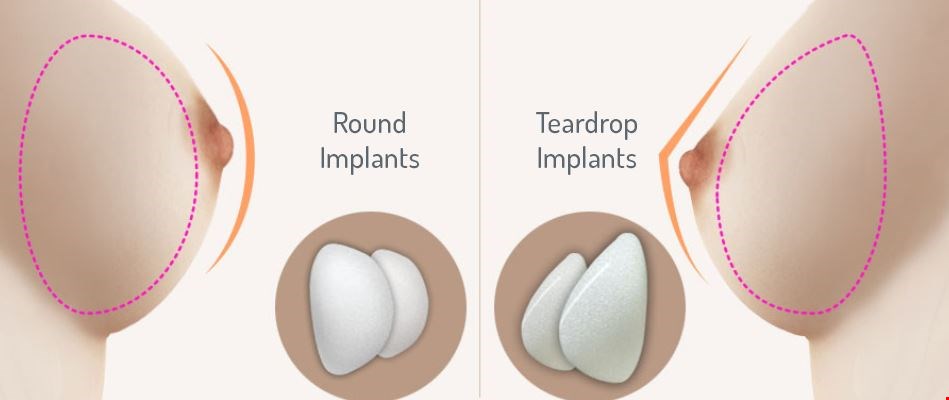
Anatomical implants, often referred to as "Teardrop implants", are distinguished by their shape that mimics that of a pear or a water droplet. This shape is closer to the natural form of many breasts, with a greater volume in the lower part of the implant than in the upper part, providing a more natural appearance in some cases.
However, these implants have certain drawbacks. One of the main risks is their potential for displacement, which can lead to asymmetry or an unusual breast shape. Additionally, their cost is generally higher than that of round implants, due to their more complex design.
Despite these drawbacks, anatomical implants remain a popular choice for those seeking a more natural result, particularly in cases of breast reconstruction or when the patient desires a specific and subtly contoured shape.
FAQ